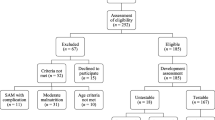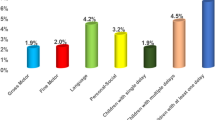Abstract
Objective
To estimate the prevalence of global developmental delay among children under 3 years of age and study the determinant factors.
Methods
Cross sectional descriptive study was conducted in field practice areas of the Department of Community Medicine, JN Medical College, Aligarh, India. A total of 468 (243 boys and 225 girls) children aged 0–3 years were included. Developmental screening was performed for each child. A multitude of biological and environmental factors were analysed.
Results
As many as 7.1% of the children screened positive for global developmental delay. Maximum delay was observed in the 0–12 months age group (7.0%). Undernutrition and prematurity were the two most prevalent etiological diagnoses (21% each). Stunting and maternal illiteracy were the microenvironmental predictors on stepwise binary logistic regression while prematurity and a history of seizures emerged significant biological predictors.
Conclusions
Developmental delay can be predicted by specific biological and environmental factors which would help in initiating appropriate interventions.


Similar content being viewed by others
References
Engle PL, Black MM, Behrman JR, et al. Strategies to avoid the loss of developmental potential in more than 200 million children in the developing world. Lancet. 2007;369:229–42.
Majnemer A. Benefits of early intervention for children with developmental disabilities Semin Pediatr Neurol. 1998;5:62–9.
Bang K. Analysis of risk factors in children with suspected developmental delays. Proc World Academy Sci Eng Technol. 2008;36:2070–3740.
Khan NZ, Ferdous S, Islam R, Sultana A, Durkin M, McConachie H. Behaviour problems in young children in rural Bangladesh. Jr of Trop Pediatr. Advance Access published online on 9 Dec 2008. doi:10.1093/tropej/fmn108.
Vazir S, Lansdown RG, Naidu AN, Vidyasagar P, Reddy V. A comparison of Indian and American scales of child development. J Indian Acad Appl Psychol. 1994;20:175–81.
Shevell MI, Ashwal S, Donley D, Flint J, Gingold M, Hirtz D, et al. Practice parameter: evaluation of the child with global developmental delay. Neurology. 2003;60:367–79.
Kumar P. Social classification-need for constant updating. Ind J Comm Med. 1993;8:59–61.
Eapena V, Zoubeidib T, Yunisc F, Gururajd AK, Sabrie S, Ghubasha R. Prevalence and psychosocial correlates of global developmental delay in 3-year-old children in the United Arab Emirates. J Psychosomatic Res. 2006;61:321–26.
Nair MKC, Radhakrishnan.RS. Early childhood development in deprived urban settlements. Indian Pediatr. 2004;41.
Persha AJ, Rao VRPS. Early intervention-A service model: early intervention to IUGR children at risk for developmental delays. Secunderabad: National Institute for the Mentally Handicapped; 2003.
Singh H, Nizamie A, Jahan M, Jagadheesan K, Nizamie SH. Profiles of individuals with mental retardation in Ranchi: a community study. Indian J Clin Psychol. 2002;29:178–85.
Packman S. Diagnostic evaluation of the child with mental retardation. In: Rudolf AM, Hoffman JIE, Rudolf CD, editors. Rudolf’s Pediatrics. Stanford, Appleton & Lange; 1996. p. 424–26.
Mathew A. Prenatal psychological stress: a significant factor in mental retardation. Disabil Impair. 2002;16:42–6.
Chung BHY, Wong V. Clinical markers that enhance etiologic yield in global developmental delay. Pediatrics. 2008;121:S145–6. doi:10.1542/peds2007–2022.
Srour M, Mazer B, Shevell MI. Analysis of clinical features predicting etiologic yield in the assessment of global developmental delay. Pediatrics. 2006;118:139–45.
Kaur H, Singh S, Malhotra D. Malnutrition and cognitive development. J Pers Clin Stud. 1985;1:23–5.
Agarwal DK, Upadhyaya SK, Tripathi AM, Agarwal KN. Nutritional status,physical work capacity and mental function in school children. Nutritional Foundation of India. Scientific report No. 6;1987.
Ramji S, Saugstad OD. Use of 100% oxygen or room air in neonatal resuscitation. NeoReviews Am Acad Pediatr. 2005;6:172.
HA Delemarre-van de Waal. Environmental factors influencing growth and pubertal development. Environ Health Perspect. 1993;101:39–44.
Ollitt E, Schurch B, eds. Undernutrition and behavioral development in children. J Nutr 1995;125: 2255–62.
Berkman DS, Lescano AG, Gilman RH, Lopez SL, Black MM. Effects of stunting, diarrhoeal disease, and parasitic infection during infancy on cognition in late childhood: a follow-up study. Lancet. 2002;359:564–71.
Haas JD, Murdoch S, Rivera J, Martorell R. Early nutrition and later physical work capacity. Nutr Rev. 1996;54:41–8.
Meenakshi M, Pradhan SK, Prasuna JG. Screening for psychosocial development among infants in an urban slum of Delhi. Indian J Pediatr. 2007;74:841–5.
Stoltzfus RJ, Kvalsvig JD, Chwaya HM, et al. Effects of iron supplementation and anthelmintic treatment on motor and language development of preschool children in Zanzibar: double blind, placebo controlled study. BMJ. 2001;323:1389–93.
Lozoff B, Jimenez E, Hagen J, Mollen E, Wolf AW. Poorer behavioral and developmental outcome more than 10 years after treatment for iron deficiency in infancy. Pediatrics. 2000;105:51.
Sameroff AJ. Environmental risk factors in infancy. Pediatrics. 1998;102:1287–92.
Hack M, Caron B, Rivers A, Fanaroff AA. The very low birth weight infant: the broader spectrum of morbidity during infancy and early childhood. J Dev Behav Pediatr. 1983;4:243–9.
Nishida H. Outcome of infants born preterm, with special emphasis on extremely low birthweight infants. Baillières Clin Obstet Gynaecol. 1993;7:611–31.
Morris BH, Miller-Loncar CL, Landry SH, Smith KE, Swank PR, Denson SE. Feeding, medical factors, and developmental outcome in premature infants. Clin Pediatr (Phila). 1999;38:451–7.
Barnard C, Wirrell E. Does status epilepticus in children cause developmental deterioration and exacerbation of epilepsy? J Child Neurol. 1999;14:787–94.
Verity CM, Golding J, Ross EM. Outcome of childhood status epilepticus and lengthy febrile convulsions: findings of national cohort study. BMJ. 1993;307:225–8.
Author information
Authors and Affiliations
Corresponding author
Rights and permissions
About this article
Cite this article
Sachdeva, S., Amir, A., Alam, S. et al. Global Developmental Delay and Its Determinants Among Urban Infants and Toddlers: A Cross Sectional Study. Indian J Pediatr 77, 975–980 (2010). https://doi.org/10.1007/s12098-010-0151-9
Received:
Accepted:
Published:
Issue Date:
DOI: https://doi.org/10.1007/s12098-010-0151-9




